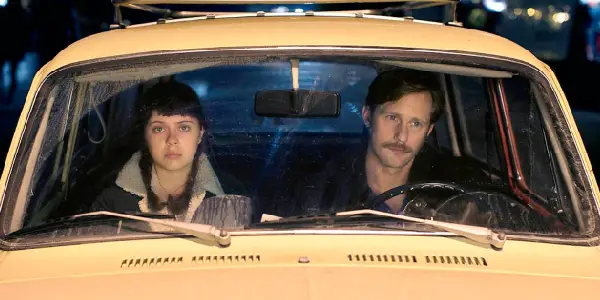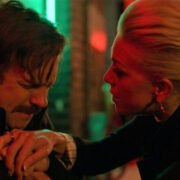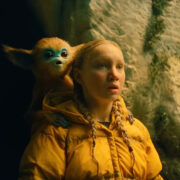The Age Gap in Romance Films

Angela Trott is a PhD Film researcher from the UK…
There has been a historical frequency in film for older men to be depicted in romantic relationships with younger, sometimes much younger, women. This article seeks to examine whether this propensity for older men to be paired with younger women on-screen can reveal something of mainstream cinema’s and, by extension, western culture’s attitudes towards older women, sex and romance. Might more contemporary examples featuring fresh approaches to the age gap be leading us down a new path, featuring a wider range of romantic perspectives?
Calling into question the motivation for these depictions of couples of disparate ages is not a new observation. There was renewed critical attention given to this discussion of ageism in cinema last year when Maggie Gyllenhaal revealed that, at 37, she had been deemed ‘too old’ to play the love interest of a 55-year-old actor. However, despite a brief outcry at the time and several media outlets reveling in the creation of age-gap infographics, as visually insightful as these were, the discussion subsided fairly quickly.
Since this renewed scrutiny on cinema’s apparent ageism when it comes to the representation of women and romance, has anything improved? At first glance, it would appear not, particularly when we take into account the attitudes exhibited by the mainstream media and even some actors themselves; for example, Russell Crowe’s comments last year that actresses who speak out about the lack of roles for older women are essentially complaining about nothing, to the apparently outraged response to Susan Sarandon’s choice of outfit at the 2016 Screen Actors Guild awards, which I will return to later.
Older Men and Younger Women
Examples of this type of relationship are easy to identify and numerous. In recent memory, we could consider the undeniably talented and immensely watchable duo of Bradley Cooper and Jennifer Lawrence, who have now played love interests in both Silver Linings Playbook and Serena despite a 16-year age gap. In American Hustle, this age difference was extended even further when Lawrence was paired with Christian Bale, who is 20 years her senior.

Another career-long culprit when it comes to pairing older men with younger women onscreen is obviously Woody Allen. Even in his most accomplished and acclaimed films, such as the classic Manhattan, and in more recent, less well-received offerings such as Magic in the Moonlight, Allen has explored the dynamic between older men and the younger objects of their affection. In Allen’s most recent film, Irrational Man, Emma Stone is an undergraduate student romanced by her professor, played by Joaquin Phoenix. It is arguably the troubling power dynamic in this last example, trading on clichéd student/teacher fantasies, that may mark that it is time for both Allen and Hollywood to move on from this trope.
There are several actors who are continuing to work prolifically throughout their 40s, 50s and 60s, such as Tom Cruise, Johnny Depp and Liam Neeson, who are repeatedly shown in onscreen romances with much younger women. As I have suggested, there would be nothing inherently problematic about this were it not for the fact that it is simply not equal to the amount of older women dating younger men onscreen, and therein lies the real issue: not of couples romancing across age divides in film, but the lack of not only representation of older women in cinema, but the tendency for men to be viewed as sexually attractive much later in life than women are permitted to be.
Older Women and Younger Men
This is not to say that we do not see older women depicted in relationships with younger men, but this type of pairing is much less frequent and when it does appear the woman is often represented as a comic or even slightly tragic figure. One only has to consider the term ‘cougar’, which has found its way into the popular lexicon, to get some idea of how these women are frequently ridiculed. Depicted as predatory, bordering on desperate, women whose enjoyment of sex with younger men is rarely told from their subjective point of view, but focuses instead on the younger man’s coming-of-age story.
The iconic image of the older woman ‘preying’ on a younger man is enduringly held up as Anne Bancroft’s character of Mrs. Robinson in The Graduate. The representation of Mrs. Robinson walked a fine line between light comedy and fetish, but the chief focus of the film was Dustin Hoffman’s role as Ben Braddock and his existentialist post-college identity crisis, with Mrs. Robinson serving as a way for him to explore his entry into adult manhood. This pattern has rarely been deviated from, and what is particularly interesting in the case of these actors is that there was only a six-year age gap between the two – yet 36-year-old Bancroft was cast to play a woman in her 40s while Hoffman was cast to play a character nearly a decade his junior. This is one of the earliest examples of the double standard in the way male and female actors are treated as they age.

A further example of the way older, sexually active women are often portrayed is embodied in another character that no doubt springs to mind when we think of the tendency for this relationship to be played for comic effect: Stifler’s mom in American Pie. She is a classic example of the attractive older woman who is granted no subjectivity or character development of her own, at least in the first installments of the series – in this case she is not even granted a name. She is a comic device and a fantasy figure for the young male characters, and by extension the target audience for the film.
One of the most common ways Stifler’s mom is referred to in the narrative is as a MILF (Mom I’d Like to F*ck), demonstrating that not only is there another even more problematic term than cougar available in now commonly-used slang, but also emphasising the way in which older women and mothers are often denied sexual desire and identity unless granted them by approving males. These women are marked as extraordinary by the implication that when women become mothers they become instantly less desirable, having apparently surrendered their own sexuality.
At the beginning of this article, I mentioned the reaction to the outfit Susan Sarandon wore to the Screen Actors Guild awards in January and it is appropriate to revisit this now, in this discussion of cultural attitudes towards older women and their sexuality. It seems that for as many people who commented positively on her appearance that night, there were just as many who felt the need to shame her online for her wardrobe choice. However, I would argue that it was not Sarandon’s choice of clothing that bothered so many commenters, some of them high profile, but the fact that a 69-year-old woman (I am reluctant to even reference her age, but it is relevant here in a way that it was not for every article or comment that referred solely to her age in relation to her appearance) was in the public eye and refusing to adhere to an apparent code of appearance that is expected of older women in Hollywood.
Exceptions to the Age Rule and Hope for the Future
While this article has primarily dealt with heterosexual couplings on-screen, there have been more varied and positive depictions of age gap romances to be found in recent same-sex relationships in cinema. In the past year alone, we have seen both Freeheld and Carol portray sensitive and richly complex romantic relationships, which cross generational divides while never playing for laughs or trading on ageist representations of older women. Perhaps it is the difference or absence of exploitative power dynamics in these relationships, or the fact that the narratives do not make the age gap a central point, but these are encouraging examples of how older women can be depicted as sexually active and as well-developed characters without the two being mutually exclusive.

One of the key issues I have highlighted with the representation of older women in romance narratives is their lack of subjectivity, and the same can be said of the young women who are paired in relationships with older men. However, there have been examples in recent years of stories of young women becoming involved with older men, told from the female perspective, resulting in a shift in tone from some of the films listed in the opening of this article. For example, British offerings such as Fish Tank and An Education handle these relationships deftly and maintain a sense of subjectivity for their young female leads, as does the wonderful The Diary of A Teenage Girl. Perhaps it is notable that all three of these films were directed by women, and with increasing numbers of women telling stories of age gap romances from an alternative perspective, we may someday reach a more balanced view.
So is it still an issue that there seem to be greater numbers of older men romancing younger women onscreen than vice versa? Do you agree that this is more a symptom of society’s attitudes towards an aging woman’s sexuality than a problem inherent in cinema?
Does content like this matter to you?
Become a Member and support film journalism. Unlock access to all of Film Inquiry`s great articles. Join a community of like-minded readers who are passionate about cinema - get access to our private members Network, give back to independent filmmakers, and more.
Angela Trott is a PhD Film researcher from the UK who divides her time between film watching, writing, teaching, and tea drinking in equal measure.










